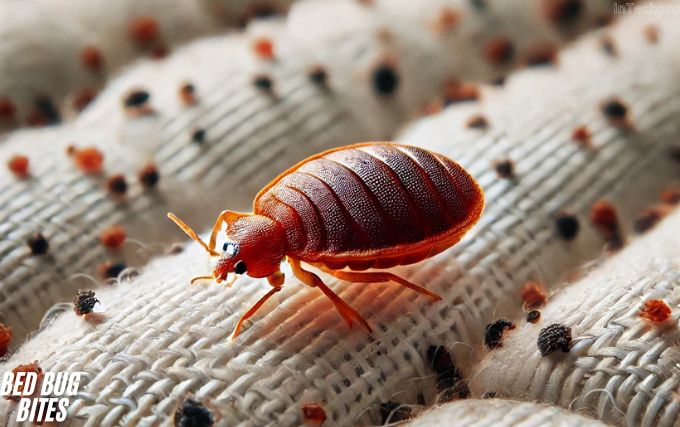Bed bug bites can be a troublesome and distressing experience for many. These tiny pests can cause significant discomfort and anxiety, particularly because they are challenging to detect and eliminate. In this article, we will delve into everything you need to know about bed bug bites, from identifying the signs and symptoms to effective treatment and prevention strategies.
What Are Bed Bugs?
Bed bugs (Cimex lectularius) are small, reddish-brown insects that feed on the blood of humans and animals. They are nocturnal creatures, typically hiding in cracks and crevices during the day and emerging at night to feed. Bed bugs are wingless and about the size of an apple seed, making them difficult to spot.
Life Cycle and Habits
Bed bugs go through several stages in their life cycle: egg, nymph, and adult. The entire process from egg to adult takes about five weeks under optimal conditions. These pests are resilient and can survive for several months without a blood meal, making them particularly challenging to eradicate.
Identifying Bed Bug Bites
Bed bug bites are often mistaken for bites from other insects, such as mosquitoes or fleas, or even for skin conditions like eczema. Accurate identification is crucial for effective treatment and prevention.
Symptoms of Bed Bug Bites
- Red, Itchy Bumps: Bed bug bites typically appear as small, red, itchy bumps on the skin. They often occur in clusters or lines, reflecting the feeding pattern of bed bugs as they move across the skin.
- Swelling and Inflammation: In some cases, bed bug bites can cause swelling and inflammation, particularly if the individual has a sensitivity to the bites.
- Bite Locations: Common areas for bed bug bites include the arms, legs, neck, face, and hands. However, they can occur anywhere on the body.
Distinguishing Bed Bug Bites from Other Bites
- Pattern: Bed bug bites often follow a linear or clustered pattern, unlike mosquito bites, which are more random.
- Timing: Bed bugs feed at night, so new bites typically appear in the morning.
- Lack of Central Puncture: Unlike flea bites, which have a central puncture, bed bug bites usually do not.
Treating Bed Bug Bites
While bed bug bites are generally not dangerous, they can cause significant discomfort and itching. Here are some effective treatments to alleviate symptoms.
Home Remedies
- Wash the Area: Clean the affected area with soap and water to reduce the risk of infection.
- Cold Compress: Applying a cold compress can help reduce swelling and numb the area, providing relief from itching.
- Over-the-Counter Treatments: Anti-itch creams, such as hydrocortisone, and oral antihistamines can help reduce itching and inflammation.
When to See a Doctor
In most cases, bed bug bites can be treated at home. However, if you experience severe reactions, such as difficulty breathing, widespread swelling, or signs of infection, seek medical attention promptly.
Preventing Bed Bug Infestations
Preventing bed bug infestations requires vigilance and proactive measures. Here are some steps to minimize the risk.
Inspecting and Cleaning
- Regular Inspections: Regularly inspect mattresses, box springs, and furniture for signs of bed bugs, such as tiny black spots (fecal matter), shed skins, or the bugs themselves.
- Vacuuming: Vacuum frequently, especially in areas where bed bugs are likely to hide, such as around beds and furniture.
- Laundering: Wash and dry bed linens, blankets, and clothing at high temperatures to kill bed bugs and their eggs.
Protective Measures
- Mattress Encasements: Use bed bug-proof mattress and box spring encasements to prevent bed bugs from hiding and breeding.
- Minimize Clutter: Reduce clutter in your home to eliminate hiding spots for bed bugs.
- Seal Cracks and Crevices: Seal cracks and crevices in walls, baseboards, and furniture to prevent bed bugs from finding hiding spots.
Dealing with an Infestation
If you suspect a bed bug infestation, it’s crucial to take immediate action to prevent the problem from worsening.
DIY Methods
- Vacuuming: Vacuum thoroughly, paying close attention to seams and crevices in furniture and mattresses. Dispose of the vacuum bag in a sealed plastic bag immediately after use.
- Steam Cleaning: Steam cleaning can effectively kill bed bugs and their eggs on contact.
- Diatomaceous Earth: Sprinkle food-grade diatomaceous earth around infested areas. This natural powder can kill bed bugs by dehydrating them.
Professional Extermination
In severe cases, professional extermination may be necessary. Pest control professionals have access to specialized equipment and treatments that can effectively eliminate bed bugs.
Myths and Misconceptions About Bed Bugs
There are many myths and misconceptions about bed bugs that can hinder effective prevention and treatment.
Myth 1: Bed Bugs Only Infest Dirty Homes
Bed bugs do not discriminate based on cleanliness. They can infest any environment where they have access to a blood meal, including clean homes, hotels, and public transportation.
Myth 2: Bed Bugs Transmit Diseases
While bed bugs can cause discomfort and allergic reactions, there is no evidence that they transmit diseases to humans.
Myth 3: Bed Bugs Are Visible to the Naked Eye
Bed bugs are small but visible to the naked eye. However, their size and nocturnal habits make them difficult to detect.
Emotional and Psychological Impact of Bed Bug Bites
The presence of bed bugs and the experience of being bitten can have a significant emotional and psychological impact. Anxiety, stress, and sleep disturbances are common among those dealing with an infestation.
Coping Strategies
- Education: Understanding bed bugs and how to deal with them can alleviate some of the anxiety associated with an infestation.
- Support: Seek support from friends, family, or support groups who have dealt with similar issues.
- Professional Help: In severe cases, consider speaking with a mental health professional to address anxiety and stress.
Conclusion
Bed bug bites can be a distressing experience, but with the right knowledge and approach, you can effectively manage and prevent them. By identifying the signs of bed bug bites, using appropriate treatments, and taking proactive measures to prevent infestations, you can protect yourself and your home from these persistent pests. Remember, if you suspect a bed bug infestation, act quickly to prevent the problem from worsening and consider seeking professional help if necessary.


I believe this internet site has some really fantastic information for everyone : D.
Very informative and good structure of articles, now that’s user genial (:.
Sweet web site, super style and design, very clean and employ genial.
I really like foregathering utile info, this post has got me even more info! .